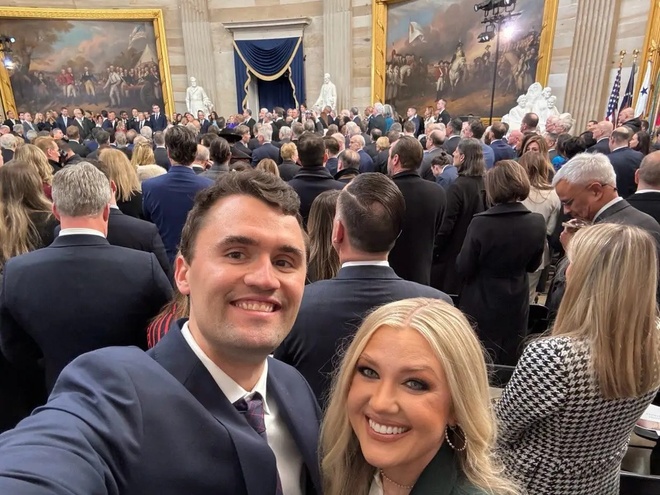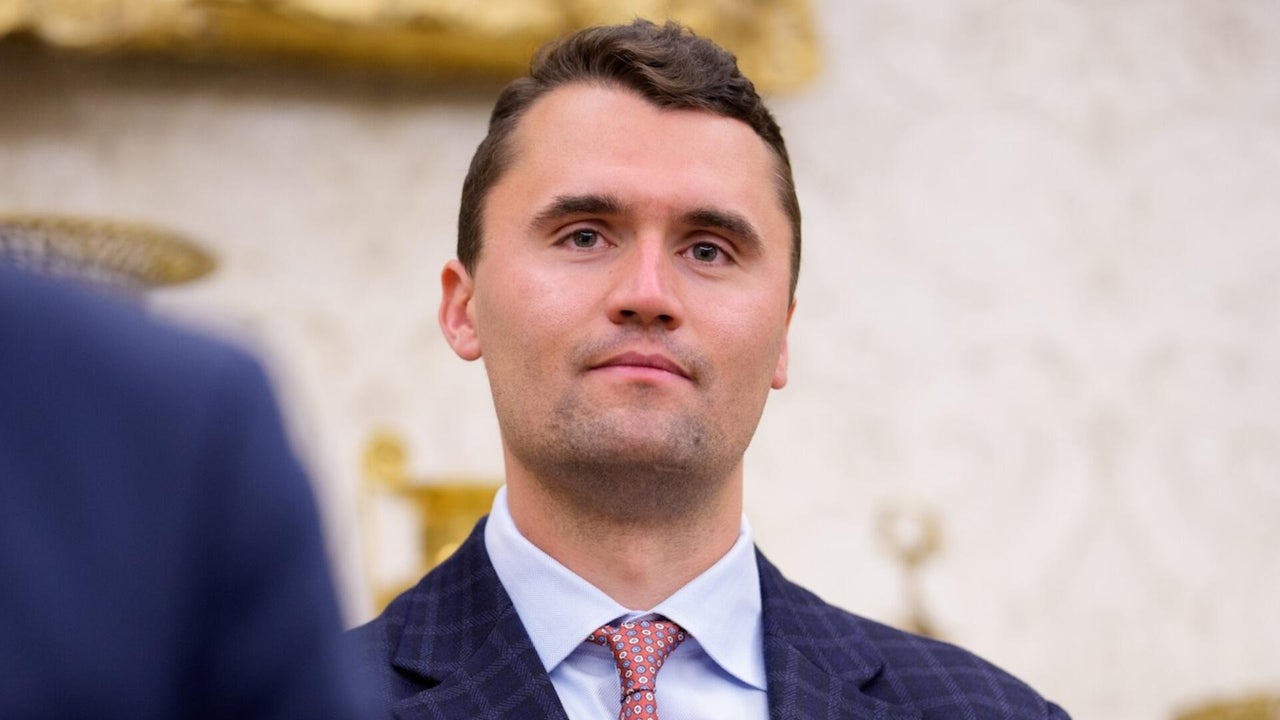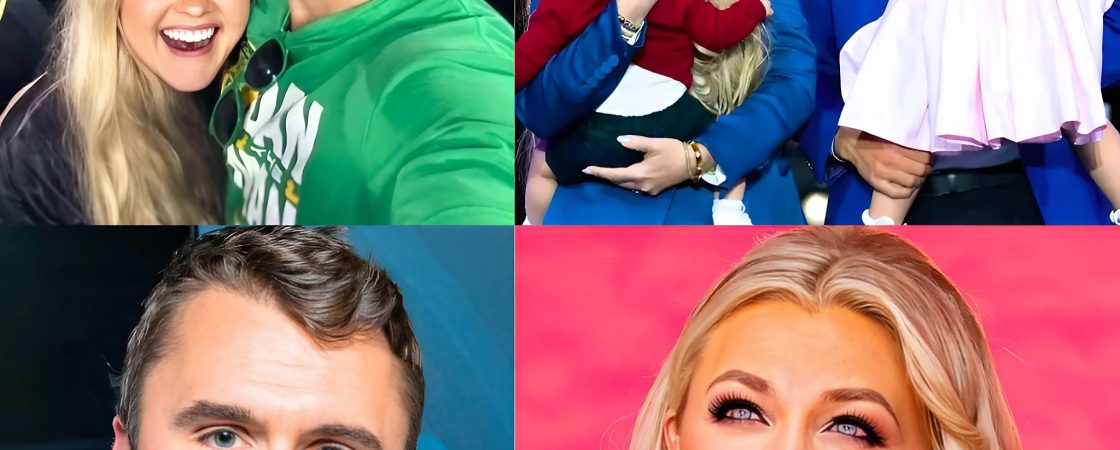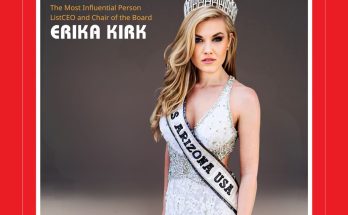On a quiet October evening, the world was stunned by the sudden death of a well-known public figure. Obituaries poured in, memorials filled social media feeds, and news networks scrambled to cover every detail of the tragic event. Amid the grief and shock, one detail has begun to capture the attention of investigators and the public alike: the financial dealings leading up to the incident.
Leaked documents, recently obtained by investigative reporters, have revealed a curious wire transfer of $350,000 to Erica Kirk, the widow of the deceased. The transfer occurred just two weeks before her husband’s death, raising questions that authorities are only now beginning to explore.
The sender of the money? A shell company that, according to corporate registries, dissolved a mere four days after the transaction. These coincidences alone could be enough to make any investigator pause.
But there is more. Sources close to the investigation say that a video has surfaced showing Erica Kirk in a private, high-stakes meeting with two unidentified men just 48 hours after her husband’s passing.
In the footage, the tension is palpable. Her posture, the gestures, and the hushed voices suggest that the conversation carried weighty implications. While the content of the meeting remains unclear, speculation is naturally unavoidable. Was this an ordinary arrangement, or something far more sinister?

Journalists and investigators alike are now focused on tracing the money. Financial forensics, a process that involves tracking the movement of funds across accounts, banks, and shell entities, has become central to understanding the situation.
Every wire transfer, every corporate registration, and every signature could hold a piece of the puzzle. In this case, the $350,000 transaction appears to have been part of a larger pattern of complex financial maneuvers.
Tracing such transfers is not straightforward. Shell companies, which are entities with no active business operations, are often used in financial schemes to obscure the origins or destination of money.
They can be created and dissolved within days, leaving minimal paper trails. This appears to be exactly what happened here. The shell company that sent the $350,000 was created, executed its transfer, and dissolved in less than a fortnight. Experts in financial crimes describe this as a classic method to prevent investigators from linking money directly to any individual.
The timing is what makes the story particularly gripping. Financial experts note that large transfers right before life-altering events often attract scrutiny. While it is entirely possible that the payment was unrelated, the proximity to the tragic death makes it difficult to ignore.
Moreover, the subsequent meeting caught on video adds an additional layer of intrigue. Meeting privately with two unknown parties within 48 hours of such a high-profile incident is a rarity. For observers, it is enough to warrant concern and curiosity.
Public reaction has been immediate. Social media platforms are rife with speculation, ranging from attempts to rationalize the transaction to theories of deeper conspiracies.
Some commenters suggest that the payment could have been a legal settlement or part of a legitimate business arrangement, pointing out that financial dealings are often complex and multi-faceted. Others, however, view the timing and secrecy as deeply suspicious. Even within responsible reporting, the narrative of “following the money” is compelling—because financial trails often reveal truths that words alone cannot.
To understand the implications, it is necessary to step back and look at historical precedents. In high-profile cases, financial transactions are frequently at the center of investigations.
The famous investigations into corporate fraud, political scandals, and other public controversies have repeatedly shown that money often tells a story that witnesses cannot or will not.
The same principle is being applied here: by analyzing every transfer, every account, and every corporate registration, investigators hope to determine whether the payment to Erica Kirk was a mere coincidence or part of a more elaborate scheme.
The broader context also cannot be ignored. Erica Kirk’s husband was not only a public figure but also a person whose influence extended into multiple spheres: media, politics, and business.
This kind of visibility can attract attention from admirers and adversaries alike, making the surrounding financial landscape more complicated. Large sums of money moving through obscure channels in the midst of high-profile scrutiny often raise eyebrows. Authorities emphasize caution, however, reminding the public that appearances can be deceiving.
Meanwhile, experts in forensic accounting and investigative journalism stress the importance of objective analysis. Every transaction has a context: the sender’s intent, the recipient’s purpose, and the documentation accompanying the transfer are critical.
Leaked documents, while illuminating, are not conclusive evidence. They provide leads, clues, and starting points for more detailed investigations. The key question remains: what was the purpose of the $350,000, and why did it coincide with such a significant personal event?

As the investigation continues, new layers of complexity emerge. The shell company involved has ties to multiple other entities, some of which are registered overseas.
Offshore transactions, in particular, add additional hurdles for authorities trying to trace the flow of funds. Legal experts point out that the combination of domestic and international financial regulations can make such inquiries lengthy and complicated. Every lead requires verification, and every discrepancy must be analyzed meticulously.
The leaked video is another critical element. Although brief, the footage provides an unusual glimpse into private actions that are rarely seen by the public. Observers note the urgency in body language, the seriousness of tone, and the apparent confidentiality of the conversation.
While there is no confirmation of what was discussed, the timing of the meeting—48 hours after a sudden and tragic death—underscores the unusual nature of the situation. Combined with the financial trail, the video contributes to a narrative that is both compelling and unsettling.
Investigators are particularly interested in the identities of the two men in the video. Without confirmation, any speculation about their involvement remains just that—speculation.
Yet, the secrecy and rapidity with which the meeting occurred naturally raise questions about their roles. Are they intermediaries, advisors, or potential accomplices? The answers may lie in a combination of financial analysis, surveillance records, and interviews with individuals familiar with the situation.
Public interest in cases like this is not just about curiosity; it also reflects broader societal concerns. People want to know whether justice is being served and whether accountability exists in powerful or high-profile situations.

The combination of sudden tragedy, large financial transactions, and secretive meetings naturally attracts attention. Responsible reporting seeks to balance the need for transparency with the necessity of avoiding unfounded accusations. In this case, the mantra of “follow the money” provides a structured framework for inquiry.
The story also highlights the importance of diligence in investigative work. Tracking financial transactions is painstaking, requiring patience, expertise, and often collaboration across borders.
Analysts review bank statements, corporate filings, and communication records. They construct timelines, identify patterns, and cross-reference information to determine connections. It is through this methodical approach that clarity can eventually emerge, even in cases where initial appearances seem suspicious.
Ethical considerations are equally important. While the public may be eager to jump to conclusions, responsible journalists and investigators maintain a careful balance.
They report facts, analyze patterns, and document findings without resorting to speculation that could unfairly harm individuals. In the context of Erica Kirk’s situation, this means highlighting the financial trail and the video evidence while clarifying that investigations are ongoing and no formal conclusions have been reached.
Moreover, this case serves as a reminder of the opaque nature of modern finance. Shell companies, wire transfers, and international accounts are tools that can serve legitimate purposes but also be exploited for concealment.
Experts caution that not all unusual transactions indicate wrongdoing, yet the combination of timing, secrecy, and the dissolution of entities shortly after transfers is enough to warrant scrutiny. Investigators must consider all possibilities, from legal business dealings to potential misconduct.
The broader implications of following the money extend beyond this single incident. Financial investigations often reveal networks, connections, and hidden arrangements that would otherwise remain invisible.
They provide insight into motivations, relationships, and the distribution of power. In high-profile cases, these investigations are essential not only for uncovering potential wrongdoing but also for building public trust in institutions and processes.
At present, authorities continue to examine every angle. They are reviewing bank records, corporate filings, and communications related to both the wire transfer and the subsequent meeting.
Forensic accountants are analyzing patterns to detect anomalies, while investigators are working to identify the individuals in the video and understand the nature of their interaction. The meticulous pace of the inquiry reflects both the complexity of the financial arrangements and the gravity of the events surrounding the case.
Public fascination is unlikely to fade. With each new document, each new video, and each newly uncovered lead, the narrative deepens. The combination of financial intrigue, sudden tragedy, and private meetings creates a story that resonates with universal themes of secrecy, accountability, and human curiosity. People naturally want to understand the forces at play behind major events, and “following the money” provides a compelling and systematic way to do so.
As the investigation unfolds, lessons emerge about vigilance, transparency, and the importance of careful documentation. Financial transactions, while often mundane in appearance, can carry extraordinary significance when examined in context.
Private meetings, when captured on video, can illuminate patterns of behavior that might otherwise remain hidden. Together, these elements form a mosaic of clues that may eventually lead to answers.

For now, the world watches, curious and cautious. Erica Kirk’s actions, the mysterious wire transfer, and the video of the private meeting remain under scrutiny. Authorities emphasize that investigations are ongoing, and that early interpretations should be tempered with patience and rigor. Yet, the path is clear: the money is the trail, and following it promises to reveal truths that might otherwise remain in the shadows.
Ultimately, this case is about more than just one person, one transfer, or one meeting. It is about the mechanisms of power, influence, and secrecy that operate behind the scenes in high-profile contexts.
It is about the challenges of understanding complex financial networks and interpreting human behavior under stress. And it is about the enduring principle that facts, meticulously examined, provide the strongest foundation for truth.
The story of the $350,000 wire transfer, the shell company, and the private meeting is far from concluded. Investigators continue their work, following leads across accounts, borders, and corporate registries.
Each discovery brings new questions, and each answer may bring us closer to understanding the larger picture. Meanwhile, the public watches, eager for transparency, clarity, and accountability.
In the end, the investigation serves as a reminder: in a world where sudden events and complex financial arrangements intersect, careful observation, rigorous inquiry, and ethical reporting are essential. Following the money is not merely a journalistic trope—it is a practical, methodical approach to uncovering hidden truths, illuminating actions behind closed doors, and holding individuals and institutions accountable.
The coming months may reveal further details about the $350,000 transfer, the shell company, and the video meeting. Perhaps new documents will emerge, perhaps new witnesses will speak, and perhaps patterns will be uncovered that clarify what currently seems opaque.
Until then, the investigation continues, guided by the principle that transparency, diligence, and careful analysis can shed light on even the darkest corners of financial and personal intrigue.

One thing is certain: the trail of money is never random. It carries with it traces of intention, connections, and influence. By following it, investigators and journalists alike can construct a narrative that is not only compelling but also grounded in verifiable facts.
In doing so, they ensure that events of significant consequence are understood not merely through rumor and speculation, but through careful, reasoned examination. And in that pursuit lies the promise of clarity, justice, and truth.
As investigators dig deeper, they are exploring not only the immediate transactions but also broader networks of influence that might explain the timing and secrecy of the transfer. Every phone record, email, and corporate filing is being meticulously examined to uncover connections that may otherwise go unnoticed.
Lucy Martinez, Chicago Teacher, Caught Laughing at Charlie Kirk’s Death — Parents Demand Action Within hours, a video showing Lucy Martinez, a teacher at Chicago Public Schools, laughing about the death of activist Charlie Kirk went viral on social media, sparking outrage online.ABC
In recent weeks, a video capturing Lucy Martinez, a teacher at Chicago Public Schools, laughing in connection with the death of conservative activist Charlie Kirk has gone viral across multiple social media platforms.
Within hours, the footage sparked national outrage, drawing attention from parents, colleagues, education experts, and the wider public. Beyond the immediate controversy surrounding Martinez, this incident has ignited broader conversations about teacher ethics, professional standards, parental expectations, and the powerful role of social media in shaping public opinion.
The video spread rapidly on platforms such as Twitter, Facebook, Instagram, and TikTok, eliciting immediate reactions from a diverse audience. Parents expressed deep concern that an educator would exhibit behavior perceived as insensitive to a high-profile death. Many felt that such actions, when captured and shared publicly, could undermine the values and lessons schools aim to instill in students.
Several parent advocacy groups quickly called for Chicago Public Schools to take immediate action. Letters and emails flooded school administrators, urging a thorough review and appropriate disciplinary measures.
The swift public response reflects a broader trend in which communities increasingly hold educators accountable not just for classroom instruction but also for how their personal behavior aligns with ethical expectations.
Beyond parents, colleagues and fellow educators were split in their reactions. Some defended Martinez, emphasizing the importance of understanding context and cautioning against snap judgments based solely on a brief video clip.
Others highlighted the professional implications, noting that educators occupy positions of influence where even private actions, once publicized, can significantly impact community trust and school reputation.
The public reaction also demonstrates how quickly incidents can escalate in the digital age. Within hours, the discussion extended beyond Chicago, reaching a national audience and prompting commentary from media outlets, education experts, and social commentators.
Facing significant public pressure, Chicago Public Schools issued a statement acknowledging awareness of the video and confirming that an internal review would be conducted.
The district emphasized that it is committed to upholding professional standards and ethical conduct among staff. However, no specific details about the timeline or potential consequences were provided, leading some community members to express frustration over perceived delays in accountability.
This situation underscores the challenges school districts face when navigating incidents that attract widespread attention. Administrators must balance due process for employees with community expectations for transparency and swift action. The response—or lack thereof—can influence public perception and trust in the educational system.
At the core of this controversy lies a broader question: what ethical obligations do educators hold beyond teaching academic content? Teachers are not only instructors but also role models whose behavior shapes students’ understanding of values such as empathy, respect, and responsibility.
Professional guidelines for teachers typically include expectations for integrity, impartiality, and maintaining a safe, respectful learning environment. In this context, publicized behavior perceived as insensitive or inappropriate may be viewed as a violation of these standards.
Even if Martinez’s actions were not intended to reach students, social media has blurred the line between private and public life, demonstrating that educators’ behavior is subject to public scrutiny.
Parents voiced specific worries about the impact of such behavior on their children. Exposure to a teacher laughing about a sensitive event can challenge the lessons of empathy, critical thinking, and moral reasoning taught in schools.
Some parents questioned whether students might internalize such actions as acceptable social behavior, potentially influencing their own interactions both online and offline.
Additionally, parents emphasized the importance of trust in the teacher-student relationship. If authority figures display behavior perceived as unethical or insensitive, it can erode students’ confidence in their educators and the school system as a whole.
The rapid spread of Martinez’s video highlights the significant role social media plays in contemporary controversies. Platforms like Twitter and TikTok enable content to go viral within hours, creating instant public discourse.
While this amplification can raise awareness of important issues, it can also distort context, oversimplify complex situations, and provoke intense public reactions based on limited information.
Social media also magnifies the consequences for professionals. Teachers, public officials, and other public-facing figures now operate under a digital microscope where private actions can become widely visible, often with lasting reputational effects.
This is not the first instance in which educators faced public backlash due to viral videos. Similar incidents across the United States have sparked national debates over teacher conduct, freedom of expression, and ethical standards.
For example, in 2020, a teacher in New York City faced disciplinary action after making controversial comments about a political figure during a virtual class session. In another case, a California teacher was reprimanded after social media posts revealed behavior deemed inappropriate for an educator.
These examples illustrate the growing tension between personal expression and professional responsibility, highlighting the need for clear ethical guidelines and training in navigating social media.
The Martinez incident emphasizes the importance of comprehensive ethics training for educators. Modern teacher preparation programs increasingly address not only classroom management and pedagogy but also professional conduct, digital literacy, and public accountability.
Educators are guided on how their online and offline behavior impacts students and the broader community. Schools are encouraged to provide policies and resources addressing social media use, public statements, and professional boundaries to prevent similar controversies.
While public outrage is a natural reaction, it is equally important to ensure fair and thorough processes for any disciplinary action. Educators are entitled to reviews that consider intent, context, and past behavior. Hasty judgments based solely on viral content can undermine principles of due process and fairness.
Chicago Public Schools faces the challenge of balancing accountability with procedural integrity. Transparent communication regarding investigations, expected timelines, and potential outcomes is critical to maintaining credibility and public trust.
Beyond controversy, incidents like this present an opportunity for educational dialogue. Students can learn about media literacy, understanding how digital content spreads, how context may be lost, and how public reactions can amplify limited information.
Teachers and administrators can guide students in critically analyzing viral content, discussing ethical considerations, and engaging in informed debate. By transforming a contentious event into a teaching moment, schools can strengthen critical thinking, ethical reasoning, and digital citizenship.
The Martinez case has fueled national discussions about the role of educators as public figures and moral exemplars. Communities expect teachers to uphold high standards of conduct while navigating the complex realities of digital media.
This controversy also raises questions about where the boundary lies between personal freedom and professional responsibility. Teachers must balance their rights to personal expression with the expectations of their profession and community. Incidents like this underscore the need for clarity in ethical standards and ongoing professional development.
Ultimately, the most significant consideration is the effect on students. Educators serve not only as instructors but also as models of behavior and ethical standards.
When teachers engage in behavior deemed inappropriate or insensitive, the implications extend to students’ understanding of morality, social responsibility, and civic engagement. Schools must prioritize creating environments where students can learn both academically and socially, supported by teachers who demonstrate ethical conduct.
The Lucy Martinez video underscores a broader societal shift: teachers are increasingly subject to national scrutiny, amplified by social media. Similar cases across the country highlight the need for ongoing conversations about teacher professionalism, social media boundaries, and community expectations.

Communities now recognize that the ethical obligations of teachers extend beyond the classroom. Educators are accountable not only to their students but also to parents, colleagues, and society at large.
As such, incidents like this contribute to ongoing debates about professional standards, accountability, and the evolving role of educators in a digitally connected world.
The Lucy Martinez controversy is more than an isolated viral incident. It serves as a catalyst for reflection on teacher ethics, professional responsibility, and the powerful influence of social media in shaping public perception.
The situation highlights the challenges educators face in balancing personal expression with professional obligations, particularly in an era where private actions can become public controversies instantly.
As Chicago Public Schools investigates and determines the appropriate response, the broader conversation continues to unfold. This incident provides an opportunity for schools, communities, and educators to reinforce ethical standards, promote media literacy, and cultivate environments where students can develop critical thinking, empathy, and responsible digital citizenship.
Ultimately, the case illustrates that teacher conduct extends beyond academic instruction—it shapes the character and values of the next generation. The outcome of this controversy will have lasting implications for both the individuals involved and the broader discourse surrounding ethics, professionalism, and accountability in education.
Inside Chicago Public Schools, the Martinez incident has sparked intense discussion among educators themselves. Teachers are acutely aware that their actions—both in-person and online—can influence students’ perception of what constitutes acceptable behavior.
Many educators expressed concern that the viral video not only impacts Martinez’s professional reputation but also casts a shadow over the entire teaching staff.
Some teachers highlighted the importance of context. They argued that a brief clip cannot fully convey intent or circumstances. Nonetheless, they acknowledged the undeniable reality: the perception of impropriety is often sufficient to trigger public backlash, regardless of intent. This tension between personal privacy and professional accountability is increasingly shaping policies within school districts nationwide.
Others emphasized the role of peer accountability. Teachers frequently mentor and monitor one another, offering guidance on professional conduct and ethical behavior. Incidents like Martinez’s serve as cautionary examples, reminding educators that personal choices—even outside the classroom—can carry profound professional consequences.
The Martinez controversy is not unique. Across the United States, numerous educators have faced scrutiny for actions captured on video or shared online. In 2018, a teacher in Texas faced suspension after students posted a video showing him making politically charged statements during a history lesson. Public reaction was swift and divided, reflecting broader societal debates over freedom of expression versus professional responsibility.
Internationally, similar cases have arisen. In the United Kingdom, several teachers faced disciplinary action after social media posts deemed offensive or insensitive were discovered.
These cases highlight a universal challenge: educators everywhere navigate an environment where personal behavior can quickly become public and subject to intense scrutiny.
Analyzing these examples reveals consistent patterns: viral content accelerates public judgment, contextual nuance is often lost, and institutions must carefully balance accountability with fair evaluation. The Martinez case fits squarely within this evolving landscape, illustrating both the opportunities and pitfalls of modern digital life for educators.

Social media does more than just spread content—it shapes the emotional and cognitive response of its users. Viral videos are engineered, often unintentionally, to provoke immediate emotional reactions. In Martinez’s case, the clip’s content elicited feelings of shock, anger, and disbelief, triggering widespread sharing and commentary.
Psychologists studying online behavior note that outrage spreads faster than neutral or positive content. This phenomenon, often referred to as the “outrage cascade,” helps explain why brief moments captured on video can dominate public discourse and place intense pressure on individuals and institutions.
Moreover, social media platforms often lack the nuance required for ethical debate. Comment sections, likes, shares, and retweets prioritize engagement over thoughtful discussion.
Educators caught in this environment must contend not only with the direct consequences of their actions but also with the amplified public scrutiny shaped by algorithmic engagement.
Given these realities, teacher preparation programs are increasingly emphasizing ethics, media literacy, and professional judgment. Courses now frequently cover topics such as digital professionalism, social media risks, and the intersection of personal expression with public responsibility.

By equipping educators with these tools, schools aim to prevent incidents that could damage both personal and institutional reputations. Ethical frameworks, case studies, and scenario-based training help teachers anticipate potential pitfalls and understand the broader consequences of their behavior.
Furthermore, mentorship programs are playing a growing role. Experienced teachers guide younger colleagues on maintaining professionalism while navigating complex social landscapes, offering advice on communication, conflict resolution, and digital conduct.
The Martinez incident demonstrates the critical role of parents and communities in shaping educational standards. Parents, as stakeholders, hold schools accountable for both curriculum and the ethical behavior of staff. Their voices in this controversy highlight the expectation that educators uphold moral standards consistent with societal norms.








